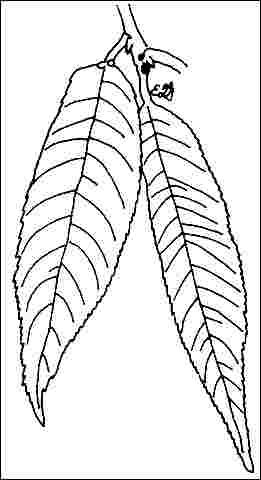Introduction
Weeping Higan Cherry grows 20 to 30 feet tall and spreads 15 to 25 feet in a graceful weeping habit. Leaves stay glossy green throughout the summer and into the fall when they turn a vivid yellow before leaving the tree bare in winter. The drooping bare branches even lend a soothing grace to the landscape in winter. There is nothing quite like the Weeping Higan Cherry in full bloom in the spring. The light pink (almost white), one-inch-diameter flowers cover the branches before the leaves emerge, giving the appearance that fresh snow has fallen on the tree.

Credit: Ed Gilman
General Information
Scientific name: Prunus subhirtella
Pronunciation: PROO-nus sub-her-TELL-uh
Common name(s): Weeping Higan Cherry
Family: Rosaceae
USDA hardiness zones: 5A through 8B (Fig. 2)
Origin: not native to North America
Invasive potential: little invasive potential
Uses: specimen; shade
Availability: not native to North America

Description
Height: 20 to 30 feet
Spread: 15 to 25 feet
Crown uniformity: irregular
Crown shape: weeping
Crown density: moderate
Growth rate: fast
Texture: fine
Foliage
Leaf arrangement: alternate (Fig. 3)
Leaf type: simple
Leaf margin: serrate
Leaf shape: oblong, ovate
Leaf venation: pinnate, brachidodrome
Leaf type and persistence: deciduous
Leaf blade length: less than 2 inches, 2 to 4 inches
Leaf color: green
Fall color: yellow
Fall characteristic: showy

Flower
Flower color: pink
Flower characteristics: very showy
Fruit
Fruit shape: oval
Fruit length: less than .5 inch
Fruit covering: fleshy
Fruit color: black
Fruit characteristics: attracts squirrels/mammals; not showy; fruit/leaves not a litter problem
Trunk and Branches
Trunk/bark/branches: branches droop; not showy; typically one trunk; thorns
Pruning requirement: needed for strong structure
Breakage: resistant
Current year twig color: brown
Current year twig thickness: thin
Wood specific gravity: unknown
Culture
Light requirement: full sun
Soil tolerances: clay; sand; loam; acidic; well-drained
Drought tolerance: moderate
Aerosol salt tolerance: unknown
Other
Roots: not a problem
Winter interest: yes
Outstanding tree: yes
Ozone sensitivity: unknown
Verticillium wilt susceptibility: susceptible
Pest resistance: sensitive to pests/diseases
Use and Management
Weeping Higan Cherry makes a striking specimen in a large yard, park or commercial landscape. Locate it to bring attention to an area, since its form is attractive all year long. Be prepared to provide more maintenance dollars to care for this beautiful tree than others. One of the premier weeping trees for American gardens, Weeping Cherry has a place in any large-scale landscape as a specimen to accent a lawn area. It is best to maintain the tree with mulch out to the edge of the canopy and with branches almost touching the ground. Even a light breeze will sway the thin, drooping branches. Very attractive close to water and often used this way.
Nurseries often graft Weeping Cherry onto a fast-growing rootstock. The rootstock cherry is trained to one straight trunk and small Weeping Cherry branches are grafted to the trunk, four to six feet from the ground.
It has a fairly rapid growth rate and prefers an open, sunny location sheltered from wind. The tree grows in almost any soil and transplants easily when young. Grows best without competition from turf grass. Clay soil is suitable as adequate moisture helps keep stress to a minimum. Irrigation is a must in sandy soil.
Other Higan Cherry cultivars are: `Autumnalis' - flowering occurs in the fall and spring in warmer climates, in colder regions it will bloom in the spring, flowers semi-double, pink; `Yae-shidare-higan' - weeping branches, flowers double, pink, and longer-lasting than `Pendula'.
Pests
Rather prone to problems, particularly in dry soil.
Aphids cause distortion of new growth, deposits of honeydew, and sooty mold.
Borers attack flowering cherries, particularly those under stress from dry soil or other factors. Keep trees healthy with regular fertilizer applications, and irrigation in dry weather.
Scales of several types infest prunus. Horticultural oil can be used to provide some control of overwintering stages.
Spider mites cause yellowing or stippling but they are very difficult to see. They are usually recognized only after plant symptoms are quite advanced.
Tent caterpillars make large webbed nests in trees then eat the foliage. One defoliation may not be serious and small nests can be pruned out and destroyed. Use Bacillus thuringiensis when the insects are first seen and are still small.
Diseases
Rather prone to problems, particularly in dry soil.
A bacterium causes leaf spot and twig cankers on Cherry. Small, reddish spots dry, and drop out, giving a shot holed appearance. Defoliation can be severe when conditions favor disease development. Fertilize infected trees and prune out infected branches.
A fungus causes reddish spots which drop out leaving shot holes. Once the hole appear the leaves may drop from the tree. The disease is worse in wet weather.
Black knot causes black swellings or galls on the branches. Branches with galls are pruned out.
Powdery mildew causes a white coating on the leaves.